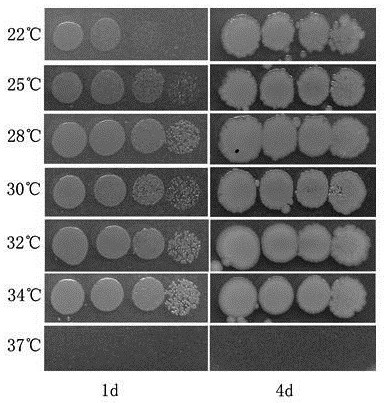Pseudomonas chlororaphis and applications thereof
A technology of Pseudomonas chloropinus and bacterial strains, applied in Pseudomonas chloropinus and its application fields, can solve problems such as environmental pollution and residual drug damage, and achieve environmental friendliness and compatibility, strong inhibitory effect, and obvious selective inhibition The effect of action
- Summary
- Abstract
- Description
- Claims
- Application Information
AI Technical Summary
Problems solved by technology
Method used
Image
Examples
Embodiment 1
[0018] Example 1: Isolation of Pseudomonas chloropinus sj19
[0019] Take materials from the bamboo whip of a dragon scale bamboo, clean the newly dug bamboo whip, cut it into small pieces of about 2cm, first sterilize the surface with 70% alcohol, and then disinfect it with 50% antifomin (sodium hypochlorite solution) for half an hour , and finally soaked in sterile water and rinsed 4-5 times. Cut the above-mentioned treated materials on the ultra-clean bench and inoculate them on the PDA medium (i.e. solid potato medium) plate. When bacteria grow out, they are respectively streaked and purified, and the DNA is extracted for molecular identification, so that Obtain and confirm the strain. The specific steps for strain confirmation are as follows:
[0020] 1) Sample collection: Scrape a small amount of bacteria to be tested from the plate into a 200 μL PCR tube, add 100 μL of sterile water, centrifuge at high speed for a short time, and remove the supernatant;
[0021] 2) S...
Embodiment 2
[0027] Example 2: Morphological and biological characteristics of bacterial strains
[0028] The sj19 strain was initially isolated and cultured on PDA medium, and the colony showed a copper-colored metallic luster ( figure 1 a, b). Microscopic observation showed that the bacteria were short rod-shaped ( figure 1 .c). Further studies showed that the optimum temperature range of Pseudomonas chloropinus sj19 was 25-34°C, and it grew better on LB medium than on PDA medium, (eg figure 2 shown). In contrast, Sj19 grew slower on PDA medium than on LB medium (eg image 3 shown).
Embodiment 3
[0029] Embodiment 3: the bacteriostasis of bacterial strain
[0030] Pick the sj19 monoclonal clone in LB liquid medium, culture it at 28°C and 150rpm for 72h, then centrifuge at 4000rpm for 10min, filter the supernatant through a sterile filter membrane with a pore size of 0.22μm, take 0.2mL of the filtrate and spread it evenly on a PDA plate On the culture medium, an equal volume of sterile water was used as a control, and a 0.5 cm glial cell anthracis bacterial block ( Colletotrichum gloeosporioides ), Botrytis ( Botryosphaeria dothidea ) and Gibberella moniliforme ( Gibberella moniliformis ), and measure the growth diameter of mycelium after culturing at 28°C for 3 days. Each treatment was replicated 3 dishes. The mold colony diameter is measured by the cross method, and the mycelial growth inhibition rate is calculated, wherein the inhibition rate (%)=[(control mold colony diameter-treatment mold colony diameter) / (control mold colony diameter-bacteria block diameter...
PUM
| Property | Measurement | Unit |
|---|---|---|
| Diameter | aaaaa | aaaaa |
Abstract
Description
Claims
Application Information
 Login to View More
Login to View More - R&D Engineer
- R&D Manager
- IP Professional
- Industry Leading Data Capabilities
- Powerful AI technology
- Patent DNA Extraction
Browse by: Latest US Patents, China's latest patents, Technical Efficacy Thesaurus, Application Domain, Technology Topic, Popular Technical Reports.
© 2024 PatSnap. All rights reserved.Legal|Privacy policy|Modern Slavery Act Transparency Statement|Sitemap|About US| Contact US: help@patsnap.com










